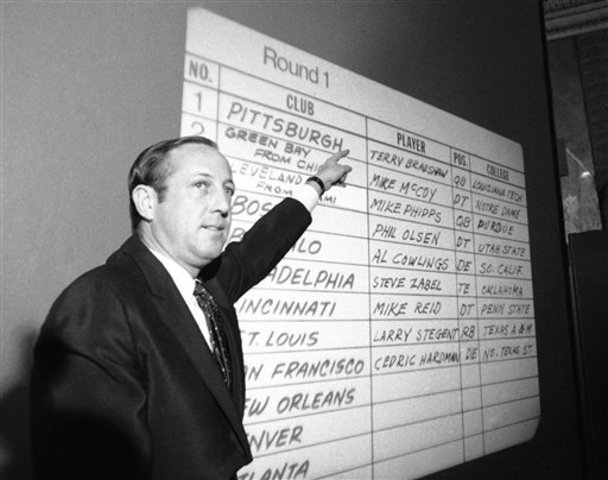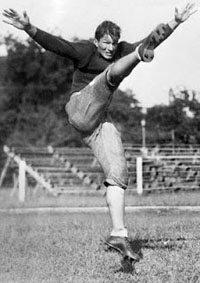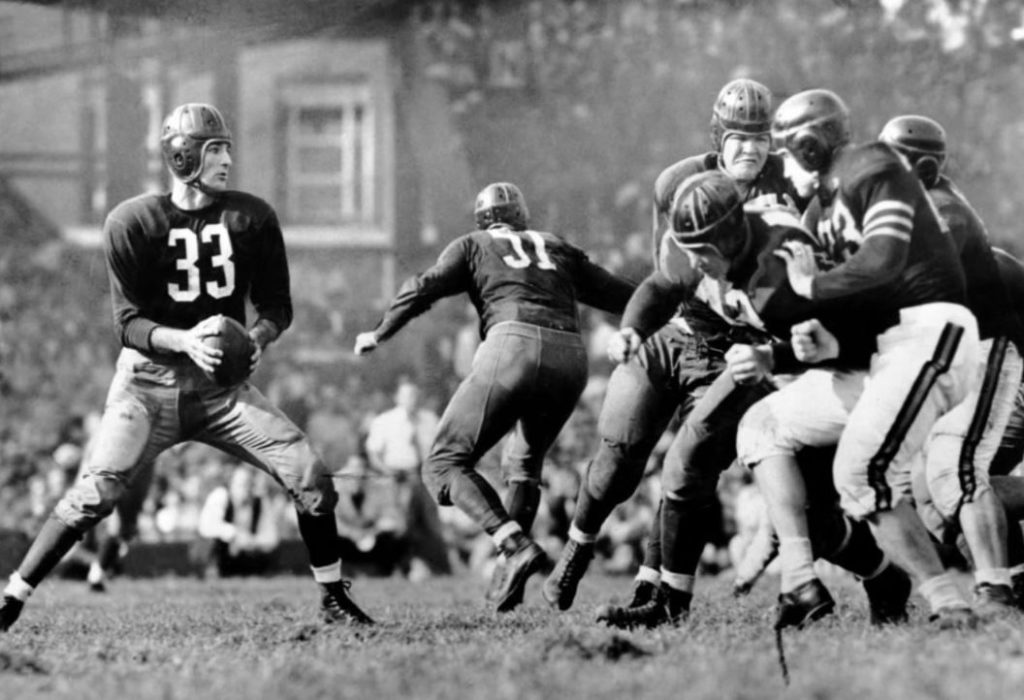
After a couple of months of speculation the 2025 NFL Draft is finally upon us. It’s a spectacle now. The League has turned what was a droll one-afternoon exercise held in a hotel ballroom into a highly produced show. If you haven’t had your fill of “Mock Drafts” yet then your thirst for speculation is un-slakable. They are out there by the dozens. Any resemblance a mock draft has to reality is more a function of blind luck than skill. The attention always goes to the top of the board. That’s where the bad teams are (unless they have traded away that pick earlier). For the first time in a long time Washington is not up there. All those top-10 selectors are hoping to turn their team’s fortunes around in a lightning strike. It usually doesn’t happen. But, it did for the WFT when it selected Jayden Daniels at #2. The Burgundy and Gold went from doormat to the Final Four. Already unthinkable it becomes a certain impossibility without Daniels. That’s the magic of the Draft in a microcosm.
Draft History
The Draft started in 1936. Prior to that the players leaving college were Free Agents in the truest sense. Teams had bidding wars to obtain rights to a player. It was the Wild West, if you will. There was no such thing as a salary cap. It was all a matter of what the Owner’s ego demanded and wallet could afford. But, as often happens the former was overwhelming the latter. Teams were in financial straights from over-spending. The League was still young, but growing. College ball was King in those days. The instability caused by the bidding wars was hampering League growth. Eventually the Owners instituted a Draft using the same inverted-results order we know today.

The first Draft is noteworthy for Washington fans. With the #2 pick the Boston franchise selected Riley Smith, a consensus All-American Quarterback at the University of Alabama. The #1 pick in the Draft was Jay Berwanger. He won the Downtown Athletic Club’s first annual trophy as the “Best Player East of the Mississippi” for his 1935 season with the University of Chicago. The trophy’s name would be changed to “Heisman Memorial Trophy” the next year and included all American schools. But, Berwanger would never play professional football.
Philadelphia had rights to the first pick. They traded them to Chicago because the front office knew that he would cost more to sign than they could pay. Jay was a superior athlete. He was chasing a berth on the 1936 Olympic team in the Decathlon. Playing pro ball would make him ineligible. He failed to make the team that went to Hitler’s Berlin with Jesse Owens. After a hardball set of negotiations Berlinger walked away from George Halas‘ offer of $13,500 a season as he insisted on a salary of $15,000 ($345,000 today.) Berwanger instead went to work at a company in the rubber industry.

Riley Smith then is the first player drafted that actually played professional football. In his first season, which happened to be the last campaign in Boston for the Redskins, the 1936 team went to the Championship Game. They lost to Green Bay 21-6. Smith was a very good athlete. He punted, kicked Field Goals, and played Defense. But, his Quarterbacking was not all that and a bag of chips. In 1936 he threw 33 passes completing only 14.
The following year Washington selected “Slingin'” Sammy Baugh. He changed the game using the forward pass in a volume not seen before. In his first season he led the League in pass attempts and completions. He would do that three more times over his career adding one year with most completions. Oh, and he and the team won the NFL Championship in his rookie year. The old adage is that you draft a potential Gold Jacket (Hall of Fame) in the first round. Slingin’ Sammy Baugh definitely qualified.
Smith would play only three seasons. In his last year he was position-designated with the obsolete title of “Blocking Back.” One big miss and one big hit for Washington in its first two attempts at 1’st-Round drafting. That’s the nature of the beast right there in a nutshell.
Some 88-Years Later…
Now second-year General Manager Adam Peters will be drafting waaay down near the bottom of the pecking order at #29. He mans the helm of a team that defied all expectations last year. The over/under for wins set by the gaming industry was 6.5 games. Amazingly the team won 12 regular season games and two playoff games. Unfortunately, that raised the bar for expectations to a very high level. Last year featured a friendly schedule. Next season is the polar opposite. The WFT is not sneaking up on anyone now. And, it’s still a team light on foundation. Many of the contracts are for one-year. NFL teams are always an ensemble cast. But, the best have a solid core under multi-year control. That’s especially true in the trenches. This franchise isn’t there yet. Those cores get built in the Draft. This is only #2 for the new management. It takes time and hits on picks to build that core.
Washington’s holes are fairly obvious. Defensive Ends (Edge) lead the list. The WFT made it to the NFC Championship Game with a porous Defense. They were 30’th against the run; 24’th for creating Turnovers; and, 27’th in Red Zone Defense. That’s not a Championship-Level Defense by any stretch of the imagination. Edges provide Sacks and “Set the Edge” against runs. Washington had 43 sacks last year good for 11’th place. But, the rushing Defense was horrid. A glaring weak spot was the failure to set the Edge. The interior of the Defensive Line was fairly solid against the run. It was the Edge that let them down repeatedly. In a classic case of having to look at the whole picture Dante Fowler‘s 10.5 sacks look impressive. However, he was not good against the run. And, now he’s gone.
So, the logical choice for Mr. Peters is to grab an Edge at #29. There are 12 or so Edges available in the first two rounds. Looking at many (too many) mock drafts the name coming up most often is Donovan Ezeiruaku, an All-American at Boston College. He is tabbed as “Bendy” meaning he’s a speed/technique pass-rusher. He is not a prototypical “Stack and Shed” run defender. The tape says he’s more than just a straight pass-rusher, a’ la Chase Young. It would certainly be an upgrade for the team.
Assume Nothing
The best way to approach this Draft for Washington is to assume nothing. There’s an argument coming below for trading down and out of the first-round altogether. Adam Peters was quite busy trading away picks for talent. As a result Washington is down to five picks: Rounds 1,2,4,6, and 7; #’s 29, 61, 128, 205, and 245. It is one of only five teams with a scant 2 picks in the top 100. Trading down to get a 3’rd top-100 pick makes a lot of sense. That’s especially true if there is an Edge sitting in the top-third of the second-round with a first-round grade. The thing is…someone has to want that #29 pick. What makes that desirable is that the picks in the first-round are eligible for the fifth-year option on the Rookie Contract. If drafting a “Developmental QB” that thought is clearly on top of mind.
What makes this Draft so intriguing is the lack of top-of-billboard QB talent. There are more teams in desperate need of a QB than the available supply. Enter Jalen Milroe. The Alabama QB is ultra-athletic. His time in the 40-yard dash was 4.37 at his Pro Day. That’s faster than all but one Running Back at the NFL Combine. His ten-yard split was in the 1.4-second range; again, very fast. And, he’s highly intelligent having won the William V. Campbell Trophy for being the best combination of academics, leadership, and on-field performance. So, why isn’t he slotted higher than his Top-100 rank of #73? The answer is his passing inconsistency. And, the reason for that is poor footwork. Of all the problems to fix for an inconsistent QB footwork is considered the easiest.
Someone may want to trade up and take a flyer on Milroe at the end of the first-round. Adam Peters may well take that call.
Of Points and Pursuits
Making sense of NFL draft pick trades is made much easier using a simple tool. Jimmy Johnson, when he was at Dallas developed a chart where each Draft Pick slot was assigned a point value. It’s very much cogent today. There is a school of thought that the top-half of the first-round is over-valued due to the “Rookie Contract” initiation in 2011. Still, teams use a points chart with their own modifications.
Washington’s 5 picks are #29, 61, 128, 205, and 245. They are worth 640, 292, 44, 9, and 1 point respectively for a total of 986 points.
Who needs to draft a QB? Start with the obvious; Titans, Browns, Giants, and Steelers. Then there are franchises with a QB, but not an elite or near-elite one: Jets, Colts, and Saints. Finally, there are the teams with a QB, but should want to put one in development; Raiders and Rams. That’s a lot of possible suitors for the #29 pick. What really juices this possibility is that the top QB prospects are going to be overpays if the neediest teams jump on them early. Cleveland could take Travis Hunter, the Colorado Cornerback/Wide Receiver at #2. Then they could jump up to #29 to take Milroe or another candidate like Jaxon Dart at #29.
Below, Adam Peters works a deal:
Let’s work this quickly: Washington gives up #29 to Cleveland for #33 and #94. Some 640-points go out the door with 704-points coming in. Perhaps Washington has to throw in #128 at 44-points to leave Cleveland with paying a 20-point premium for moving up. That’s perfectly within the realm of possibilities. It would give Washington the vaunted third pick in the top-100. It also would give them the #33 pick. That’s the Cat Bird Seat. Whichever team has that pick will take phone calls all night long from wannabe trade partners.
You could do this exercise all day long with lots and lots of scenarios. Here is an excellent points chart that allows one to select a team to see their situation. But, the bottom line is that Adam Peters trading out of the first round is viewed here as more likely than not.
Final Thoughts before the Draft
-The Day-Three Rounds: Four-Seven are easy to ignore. Look at the 7’th round point totals: in total, the 7’th Round comprises the value of a mid-4’th Round selection. Taken in aggregate the Day-3 selections represent only 6% of that Draft total points. But, the reality is that the average NFL roster has 32% of their starters coming from the Day-3 Draft rounds.
-Washington is down four-picks over two years; two this year two at the next Draft. That increases the likelihood of trading down.
-The Cornerback Room does not feel settled. Marshon Lattimore did not perform well after the trade. We will see if that was injury or age-related here soon. Picking up a Corner with a pick is entirely reasonable. There are 11 of them ranked in the top-100. Coincidentally, one pegged as a Day One Starter is Jahdae Barron ranked conveniently at #30.
-Even more conveniently ranked is Running Back Omarion Hampton from North Carolina at #29. That might get WFT fans to throw things at the TV screen. Detroit fans did that when they drafted Jahmyr Gibbs at #12 overall. There are no complaints now. Elite RBs still have amazing impacts. That Barkley guy carried the Eagles last year until their passing game got on track in the playoffs. Washington’s RB Room is average? Even though the rushing totals looked good from last year. Much of that had to do with Mr. Daniels. And, all of the team’s RBs are on expiring contracts.
-A speedy Wide Receiver would also be a nice get. He doesn’t have to be a top-shelf talent. But, he does need top-shelf speed to blow the top off of a Defense playing “Quarters” like Philadelphia. There are a couple of 4.3+ second guys in the top-100 slated for the 4’th round. Jaylin Lane from Virginia Tech and Keandre Lambert-Smith from Auburn are two.
Popcorn Time
The televised action starts on Thursday, April 24’t at 8 pm. There are various ways to watch it. This link to NFL.com will give you the options.
–

